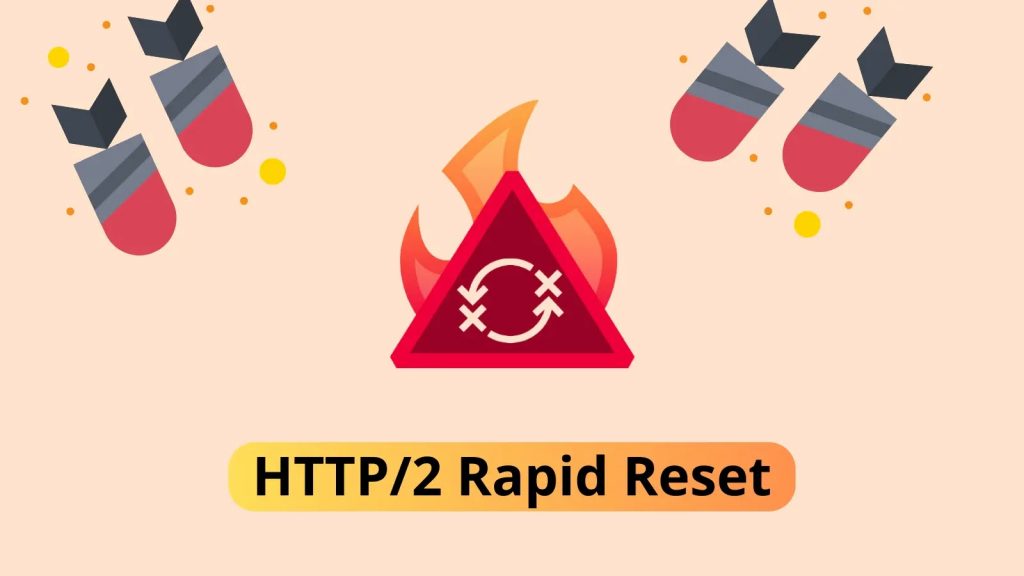At its core, CVE-2023-44487 reveals a vulnerability in the HTTP/2 protocol that malicious actors can exploit to execute the Rapid Reset DDoS attack. This novel attack technique leverages HTTP/2’s stream cancellation feature, allowing threat actors to inundate servers or applications with a barrage of seemingly innocuous requests that are instantly canceled. The scale and sophistication of this attack can overwhelm and potentially incapacitate systems relying on HTTP/2.
Exploring the HTTP/2 Vulnerability: Unprecedented DDoS Attacks:
- In the ever-evolving world of cybersecurity, new threats and vulnerabilities continue to emerge. The most recent addition to this ominous list is the “HTTP/2 Rapid Reset” vulnerability, a term that has sent shockwaves through the online security community. This blog post delves into what this vulnerability entails and why it has garnered such attention.
The HTTP/2 Protocol
Before we can understand the vulnerability, it’s crucial to grasp the significance of the HTTP/2 protocol. HTTP/2 is the second major version of the Hypertext Transfer Protocol, which is the foundation of data communication on the World Wide Web. It was developed to improve the performance and efficiency of web applications by addressing some of the limitations of its predecessor, HTTP/1.1.
Exploiting HTTP/2: The Rapid Reset Attack
The HTTP/2 Rapid Reset vulnerability, as the name suggests, exploits a weakness in the HTTP/2 protocol. It revolves around the concept of stream cancellation within HTTP/2. Normally, when a client sends a request to a server using HTTP/2, it can cancel the request if it’s no longer needed. This is a fundamental part of the protocol’s efficiency and ability to manage multiple requests simultaneously.
However, in the hands of malicious actors, this seemingly innocuous feature becomes a potent tool for generating Distributed Denial of Service (DDoS) attacks. The attackers automate a repetitive pattern of sending requests and immediately canceling them, creating a “request, cancel, request, cancel” loop at an unprecedented scale.
Unprecedented Scale of Attacks
What makes the HTTP/2 Rapid Reset attack truly concerning is the scale at which it operates. The vulnerability allowed threat actors to create DDoS attacks of an unparalleled magnitude. The most alarming aspect is that these massive attacks were carried out by relatively small botnets, comprising around 20,000 machines. In the world of cyberattacks, this is considered a modest-sized botnet, and yet it managed to inundate servers and applications running HTTP/2.
The attacks also utilized botnets in conjunction with the HTTP/2 vulnerability to amplify the rate of requests. This put immense pressure on systems, causing some intermittent edge instability. While the majority of incoming attacks were mitigated, a small number of customers experienced performance issues with 4xx and 5xx errors.
The Response and Mitigation Efforts
Once the vulnerabilities were discovered and attacks were underway, security teams and organizations took immediate action. Cloudflare, in collaboration with industry peers, developed purpose-built technology to mitigate the effects of the zero-day vulnerability. This collective effort significantly increased the overall mitigation capabilities and resiliency of the network.
Additionally, web server software partners were alerted to develop patches to prevent the exploitation of this vulnerability. The aim was to ensure that systems could withstand this type of attack, protecting the vast portion of the internet reliant on these networks.

Concussion
As digital infrastructures continue to advance, so do the tactics employed by malicious actors. Rapid Reset exemplifies how even fundamental protocols like HTTP/2 can become the target of sophisticated and disruptive attacks. The onus is on organizations to adapt and fortify their defenses continually.
CVE-2023-44487 serves as a clarion call to the cybersecurity community. It highlights the importance of information sharing, collaboration, and the collective effort to stay ahead of emerging threats. As security experts work diligently to develop mitigations and solutions, the digital realm remains a battleground where defenders must remain ever-vigilant.
In this dynamic cybersecurity landscape, the resilience of organizations will be tested. While CVE-2023-44487 presents a formidable challenge, it is also an opportunity for the community to unite, strengthen defenses, and reaffirm their commitment to a safer digital future. The battle against cyber threats continues, and CVE-2023-44487 is a testament to the unwavering spirit of those who stand guard in the realm of cyberspace.
For more information you can checkout cve.org website: Click here
- Need to Update.



